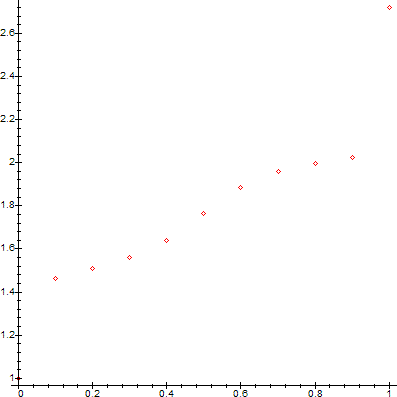
The tetraroot or hyperroot[1] of order n of x, 1/nx is defined by the rule:
1/nx=y <=> x=ny, or equivalently: n(1/nx)=1/n(nx)=x.
There appears to be a process based on continued fraction decomposition which allows the reduction of any rational hyperexponent in tetration to a tetraroot hyperexponent (a unit fraction). The process for the interval (0,1) can be summarized as follows:
Given m/n with GCD(m,n)=1 and 0<m/n<1:
Let's see an example:
What is 7/11e? Call it a1. Then, applying the algorithm above:
7/11e=a1=>
e=11/7a1 (mirror)=>
e=a1(4/7a1) (use definition)
Now we are looking for 4/7a1:
4/7a1=a2=>
a1=7/4a2 (mirror)=>
a1=a2(3/4a2) (use
definition)
Now we are looking for 3/4a2:
3/4a2=a3=>
a2=4/3a3 (mirror)=>
a2=a3(1/3a3) (use
definition)
We now back substitute everything, to obtain:
e=a1a2=>
e=(a2(3/4a2))a2=>
e=(a2a3)a2=>
e=((a3(1/3a3))a3)(a3(1/3a3))
Now we only need solve the last equation for a3. Solving with Maple, we get: a3=1.418200508
We remember that we are looking for a1, and using again back substitution, we get:
a1=a2a3=>
a1=(a3(1/3a3))a3
Substituting a3=1.418200508 into the above, we get:
a1=1.892317939 =>
7/11e=a1=1.892317939.
The algorithm 1-3 can easily be seen to be equivalent to the Maple code:
> reduce:=proc(m,n)
> local T,M,N;
> M:=m;N:=n;
> print(M,N);
> while M>1 and M<>N do
> T:=M;M:=N;N:=T;#flip
> print(M,N);
> M:=M mod N;#reduce
> print(M,N);
> od;
> end:
In the above example, the reduction was:
> reduce(7,11);
7, 11
11, 7
4, 7
7, 4
3, 4
4, 3
1, 3
It is easy to see that for any fraction m/n, with GCD(m,n)=1 and m/n<1, this algorithm always terminates on a unit fraction, hence tetrating to any rational can be expressed in terms of tetrating with tetraroots.
Let us see what happens with all the rational numbers m/10, m in {0,1,...,10}. Calculating the corresponding values for m/10, we find:
Plotting the values:

The function appears[2] to be monotone increasing (although this is no actual proof). Although it looks discontinuous at 0 and 1, no statements can be made about its monotonicity, continuity, differentiability on (n,n+1), for Narural n including 0.